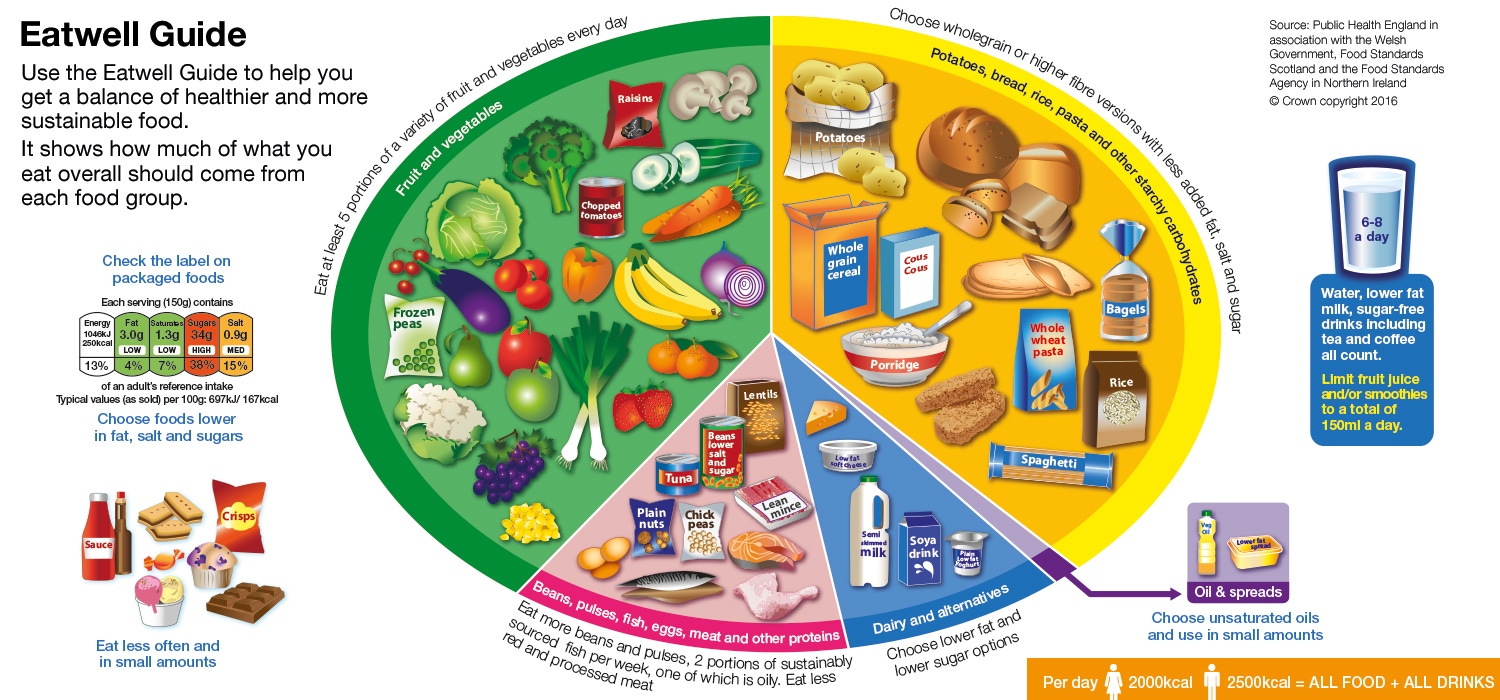Top Tips For a Healthy and Balanced Diet
The Eatwell Guide has been created by Public Health England to show us what types and the proportion of different foods that should be included in the diet. We should aim to choose a variety of different foods from each of the groups as this will help us get a healthy and balanced diet.
To eat a healthy and balanced diet, we should:
1.Eat at least 5 portions of a variety of fruit and vegetables every day - about a third of the food we eat each day should come from this food group.
2.Base meals on potatoes, bread, rice, pasta or other starchy carbohydrates; choosing wholegrain, higher fibre options where possible e.g. brown bread or pasta.
3.Have some dairy or dairy alternatives (such as soya drinks); choosing lower fat and lower sugar options.
4.Eat some beans, pulses, fish, eggs, meat and other proteins (including 2 portions of fish every week, one of which should be oily e.g. salmon or tuna)
5.Choose unsaturated oils and spreads such as olive oil and lower fat spreads over butter, and eat in small amounts.
6.Drink 6-8 cups/glasses of fluid a day, with sugary drinks being avoided.
If consuming foods and drinks high in fat, salt or sugar are not needed in the diet so we should try to have these less often and in small amounts.
For more information about eating a healthy and balanced diet visit: Eat Well Guide
Reference Nutrient Intakes
Reference intakes are a guidance on the maximum amount of calories and nutrients you should eat in a day. These values will change depending on your age, gender and activity level.
The reference intake percentage on the traffic light of products shows you how much of your reference intake each portion of that food contains. example helps them to do this e.g if a sandwich’s RI for salt is 50% this means it contains half your recommended maximum salt intake for one day.
For more information on reference nutrient intakes visit: https://www.nhs.uk/live-well/eat-well/what-are-reference-intakes-on-food-labels/
Where the Brand Fits, and How Can we Help?
Each of our Maggi So Juicy and So Tender products come with a delicious recipe idea, helping to bring exciting flavours to your dinner table. Using ingredients that you know and love, our Maggi meal ideas are developed by our in house Chefs and Nutritionists to ensure they are balanced, varied, and taste delicious. All of our recipes use a variety of food groups and are below 600kcal as recommended by the government’s ‘One You’ campaign, as a calorie guidance for our main meal. What’s more, each tasty meal contains two portions of vegetables, making it easier for all the family to get their 5 A Day. From our Thai Green Curry to our Lemon and Dill Salmon, you can rest assured that our tried and tested recipes will allow you to bring authentic flavour and a balanced meal to your family.
Did you know, our 3 Minute Noodles contain 30% less fat and 25% less salt, than the market average, without any artificial colours or preservatives and without compromising on taste. Why not try them as part of a quick, balanced meal with some veg and a lean protein, such as leftover chicken breast and some frozen peas.
Nutrition Labelling
It’s important to be able to read labels and make informed decisions about the food that we eat. Before consuming a product, always check the nutrition label. Checking the nutrition label is a good way to compare products, make healthier choices and eat a balanced diet.






